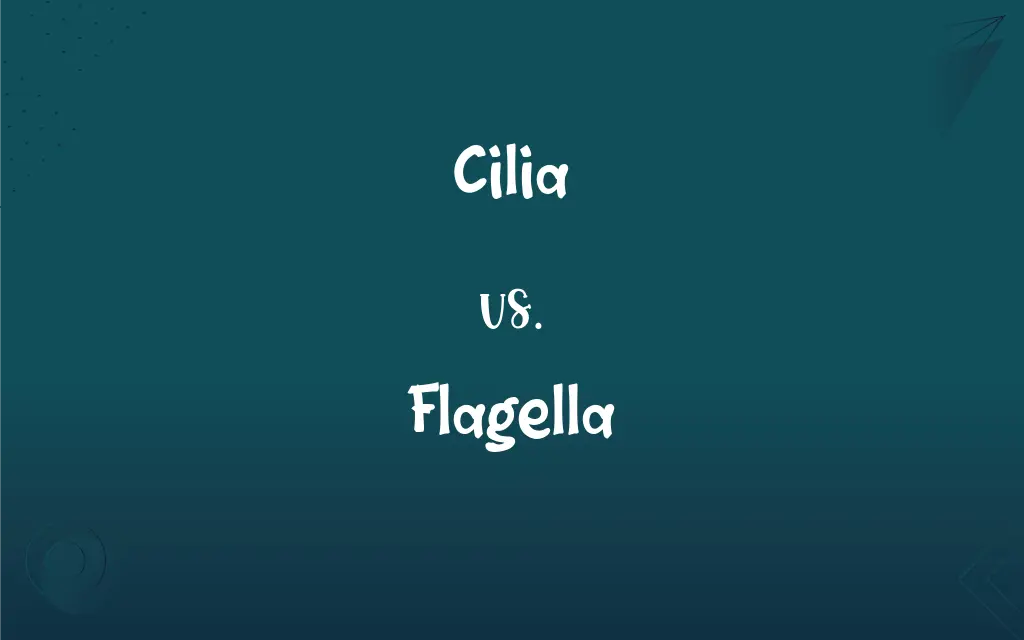Cilia vs. Flagella: What's the Difference?
Edited by Aimie Carlson || By Harlon Moss || Updated on October 28, 2023
Cilia are short, hair-like structures on cell surfaces, while flagella are longer whip-like appendages used for movement.

Key Differences
Cilia are tiny, hair-like projections found on the surface of many cells. These structures beat in coordinated patterns, helping in functions such as movement or fluid flow. Flagella, in contrast, are longer whip-like appendages. They typically exist singly or in pairs and propel cells, like certain bacteria, forward.
Cilia often serve to move substances over the surface of the cell, such as mucus in the respiratory tract. On the other hand, flagella are primarily concerned with propelling the entire cell through its environment. For instance, the flagella of sperm cells enable them to swim towards an egg.
Both cilia and flagella share a common structural basis in eukaryotes, called the "9+2" arrangement of microtubules. However, in terms of sheer size, flagella are generally longer. Prokaryotic flagella, such as those on bacteria, have a different structure and are composed of the protein flagellin.
Cilia and flagella are believed to have a shared evolutionary origin, given their structural similarities in eukaryotic cells. Despite these resemblances, their functions have diversified over time. While cilia often work in large numbers for coordinated movements, flagella usually operate individually or in small numbers for propulsive action.
Defects in cilia can lead to medical conditions like primary ciliary dyskinesia, affecting the respiratory system. Flagella, especially those on pathogenic bacteria, can be targets for antimicrobial treatments. Understanding these structures aids in both biology and medicine.
ADVERTISEMENT
Comparison Chart
Size and Number
Shorter, often numerous on a cell
Longer, typically few per cell
Function
Moves substances over cell surface
Propels the cell through its environment
Structural Composition
"9+2" microtubule arrangement in eukaryotes
"9+2" in eukaryotes; flagellin in bacteria
Occurrence
Found on many eukaryotic cells
Common in bacteria, some eukaryotic cells
Examples
Respiratory tract cells
Sperm cells, many bacteria
ADVERTISEMENT
Cilia and Flagella Definitions
Cilia
Structures often involved in sensory functions.
Certain cilia in the nose detect odor molecules.
Flagella
Long structures propelling certain cells.
Sperm cells have flagella that enable them to swim.
Cilia
Microscopic structures assisting in fluid flow over cells.
The cilia in our airways prevent dust from reaching our lungs.
Flagella
Whip-like appendages aiding cellular movement.
Bacteria use flagella to swim towards nutrient-rich areas.
Cilia
Cellular extensions with coordinated beating patterns.
Cilia in the fallopian tubes assist in moving the egg.
Flagella
Appendages with varied structures across species.
Flagella in bacteria differ structurally from those in eukaryotes.
Cilia
Tiny appendages sharing a common origin with flagella.
Both cilia and flagella have an evolutionary link, with diversified functions.
Flagella
Singular or paired structures for propulsion.
Some bacteria have multiple flagella for enhanced movement.
Cilia
Hair-like projections on cell surfaces aiding in movement.
Cilia lining the trachea help move mucus and trapped particles.
Flagella
Tail-like projections derived from ancestral cells.
The flagella's evolutionary origin is believed to be shared with cilia.
Flagella
Plural of flagellum.
Flagella
Plural of flagellum
FAQs
Can a cell have both cilia and flagella?
It's rare, but some cells might possess both structures, each serving different functions.
Are cilia only found in humans?
No, cilia are found in many eukaryotic organisms, not just humans.
How do flagella propel cells?
Flagella move in whip-like motions, pushing the cell forward.
What's the primary role of cilia in the respiratory system?
Cilia move mucus and trapped particles out of the respiratory tract.
Can bacteria move without flagella?
Some can, using other mechanisms, but flagella are primary means for many.
Are the flagella in bacteria and eukaryotes identical?
No, their structures differ, with bacterial flagella being made of flagellin.
How are flagella attached to the cell?
They are anchored to the cell membrane via a basal body.
Are cilia involved in sensation?
Yes, some cilia, like those in the nose, are sensory.
What diseases are related to defective cilia?
One example is primary ciliary dyskinesia affecting the respiratory system.
Are flagella present in all bacteria?
No, not all bacteria have flagella.
Do cilia and flagella have the same origin?
Evolutionarily, they are believed to have a shared origin.
Can a single cell have multiple flagella?
Yes, some cells, especially certain bacteria, have multiple flagella.
Are cilia always active?
No, their activity can vary depending on the cell's needs and environment.
Why are cilia essential for the female reproductive system?
Cilia help transport the egg through the fallopian tubes.
Why are flagella important in reproduction?
Flagella in sperm cells enable them to swim towards the egg.
How are bacterial flagella different from eukaryotic ones?
Bacterial flagella are made of flagellin, while eukaryotic ones have a "9+2" microtubule structure.
Do all cells have cilia?
No, not all cells possess cilia.
Do all eukaryotic flagella serve the same function?
While primarily for movement, the exact function can vary depending on the cell type.
How do cilia move?
They beat in coordinated patterns, often moving substances over the cell surface.
What's the main function of cilia in the eyes?
Cilia help move fluid across the eye's surface, keeping it moist.
About Author
Written by
Harlon MossHarlon is a seasoned quality moderator and accomplished content writer for Difference Wiki. An alumnus of the prestigious University of California, he earned his degree in Computer Science. Leveraging his academic background, Harlon brings a meticulous and informed perspective to his work, ensuring content accuracy and excellence.
Edited by
Aimie CarlsonAimie Carlson, holding a master's degree in English literature, is a fervent English language enthusiast. She lends her writing talents to Difference Wiki, a prominent website that specializes in comparisons, offering readers insightful analyses that both captivate and inform.































































